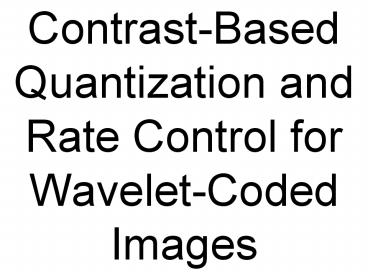Contrast-Based Quantization and Rate Control for Wavelet-Coded Images PowerPoint PPT Presentation
1 / 27
Title: Contrast-Based Quantization and Rate Control for Wavelet-Coded Images
1
Contrast-Based Quantization and Rate Control for
Wavelet-Coded Images
2
Damon Chandler and Sheila Hemami Visual
Communications Lab School of Electrical and
Computer Engineering Cornell University
3
Psychophysical Experiments
4
Compression Results
5
Introduction
6
Algorithm
7
Contrast of Quantization Distortions
8
- Wavelet-based lossy image compression entails
quantization of subband coefficients, a process
which induces distortions in the reconstructed
image. These quantization distortions are
localized in spatial frequency and orientation,
and they are spatially correlated with the image.
9
We have quantified human visual responses to
wavelet subband quantization distortions via
psychophysical testing and we have incorporated
the psychophysical results into a contrast-based
quantization strategy.
- A quantizer step size is selected for each
wavelet subband such that the distortions induced
via quantization exhibit specific contrast
ratios. - Contrasts are selected based on
- masked detection thresholds
- A model of visual error-pooling
- visual scale-space integration (global
precedence).
10
Experimental Protocol
- Paradigm Contrast detection thresholds measured
via Method of Adjustment (MOA) - Observers 50 subjects selected from the Cornell
community. - Apparatus
- Display visual resolution 36.8 pixels/deg
- gamma 2.3.
- Stimuli
- DWT 9/7 biorthogonal filters 5 decomposition
levels. - Targets Simple and compound wavelet subband
quantization distortions - Simple targets LH,HL distortions _at_ levels 1
through 5 - Compound targets LH,HL distortions _at_ levels
34, 45 LHHL distortions
_at_ levels 3,4,5 - Masks Uniform gray field (i.e., no mask) and 15
grayscale natural images.
11
Experimental Results
- Detection of simple distortions
- Contrast thresholds (CTs) vary with spatial
frequency. - Equal thresholds for horizontal (LH) and vertical
(HL) distortions. - Models
- Visual error pooling
- Model
- Unmasked ß ? 3.4 masked-by-image ß ? 1.
- Suprathreshold effects
- Image structure is visually processed from coarse
to fine scales ? discard subbands in a
fine-to-coarse scale progression.
12
Detection Thresholds
13
(No Transcript)
14
Wavelet Subband Quantization Distortions
- The spatial frequency and orientation of the
quantization distortions depends on which subband
is quantized. - The contrast of the quantization distortions
depends on - the granularity of the quantizer (i.e., the
quantizers step size) - statistical properties of the image and subband
- physical characteristics of the display (e.g.,
monitor gamma).
15
RMS Contrast
Luminance of the ith pixel
Average background luminance
- Used to quantify the intensity of the
quantization distortions. - Commonly used for compound, texture-, and
wavelet-based targets. - Low computational overhead.
16
Dynamic vs. static quantization
Consider a predominantly vertical image
Quantizing this images level-2 subband yields
the following contrast-vs.-quantizer-step-size
trends.
17
? Must compute quantizer step sizes dynamically
to account for these subband-specific trends.
18
(1) Select a baseline contrast C0 based on the
desired rate or quality.
(2) Compute the total perceived contrast based on
C0 and a linear visual error-pooling model.
19
(3) Compute a contrast C(s) for each subband s
based on C0 and the total perceived contrast.
20
(4) Compute a quantizer step size ?(s) for each
subband s such that the distortions due to
quantization of s exhibit a contrast C(s) in the
reconstructed image.
DWT level
kurtosis
standard deviation
21
(5) Quantize each subband s using step size ?(s).
(6) Entropy code the subbands and check the rate
adjust C0 and repeat steps (2) and (3) as
necessary to meet the target rate.
22
Baseline JPEG-2000 PSNR 28.3
23
Contrast-Based Strategy PSNR 24.8
24
Baseline JPEG-2000 PSNR 20.9
25
Contrast-Based Strategy PSNR 20.6
26
Contrast and Bit Allocations
27
Conclusions
- The contrast-based algorithm described here
succeeds at preserving visual quality by
indirectly allocating bits to each subband based
on appointed contrast ratios. These contrasts
are selected based on
- Contrast detection thresholds.
- A linear model of suprathreshold visual error
pooling. - Higher-level effects which are uniquely imposed
by natural image maskers (e.g., global
precedence).
For further information on this work, please
visit http//foulard.ece.cornell.edu/DCQ.html

